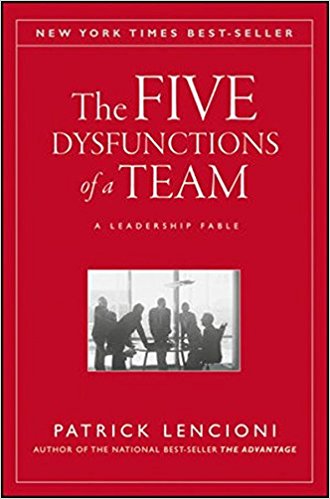The Five Dysfunctions of a Team
5 min read ⌚
 A Leadership Fable
A Leadership Fable
The best way to learn something is through a story. That’s why, upon realizing this, business writers started sharing their experiences through a new genre, the business fable.
And one of the most famous among them is, certainly, Patrick Lencioni’s “The Five Dysfunctions of a Team.”
Who Should Read “The Five Dysfunctions of a Team”? And Why?
You can’t have a winning football team if you build it around exceptional individuals. A team of average players with a teamwork mentality will beat your team nine times out of ten.
If you wonder why, then you should read “The Five Dysfunctions of a Team.” It explains the prerequisites of great teamwork, and the way you can turn your company from a haphazard mixture of lone wolves into an interpersonal heaven breeding cohesiveness and creativity at the speed of light.
About Patrick Lencioni
 Patrick Lencioni is an American author and motivational speaker. He is the President of The Table Group, a management counseling company. Lencioni has written ten books on different aspects of business management, mostly focusing on the importance of teamwork.
Patrick Lencioni is an American author and motivational speaker. He is the President of The Table Group, a management counseling company. Lencioni has written ten books on different aspects of business management, mostly focusing on the importance of teamwork.
He is most famous as the author of “The Five Dysfunctions of a Team” and “The Advantage.”
Find out more at https://www.tablegroup.com.
“The Five Dysfunctions of a Team PDF Summary”
We’ve already introduced you to the “business fable” genre. We’ve read together some early examples such as “Who Moved My Cheese?” and “The One Minute Manager” as well as some recent ones such as “The Phoenix Project.”
Now it’s time for one of the most famous and enduring works in the genre: “The Five Dysfunctions of a Team.”
In its bare essence, the fable concerns the fictional company DecisionTech, Inc. Its main characters include Kathryn Petersen, the newly appointed CEO, Jeff Shanley, her predecessor and cofounder, and a host of employees, such as: Jan, CFO; Nick, COO; Michelle, the Head of Marketing; Martin, the Chief Technologist; Jeff, the Head of Sales; and Carlos, the Head of Customer Support.
Through the stories of their day-to-day challenges and triumph, Lencioni manages to teach us few valuable lessons on what it means to be a functional team.
And he uses the best learning strategy: by reminding us the consequences of a dysfunctional working environment.
So, what are the five dysfunctions of a team?
Well, Kathryn Petersen, the CEO, explains these via a simple drawing, not unlike Maslow’s hierarchy of needs. Namely, a five-sectioned pyramid which should look something like this.
And at the bottom of the triangle, you’ll find absence of trust.
Absence of trust is the foundation of all dysfunctions. And the root of it is the inability and unwillingness of employees to be vulnerable and open to each other. Teams which share personal insights and experiences always show better results!
Next, fear of conflict.
Conflict is nothing bad. In fact, if regulated, it’s usually more productive than you can imagine. Artificial harmony does nobody any good. So, dare to disagree.
Thirdly, lack of commitment.
Healthy conflict usually results in commitment. People don’t like compromises and especially not orders. Lack of conflict and discussion, in other words, means lack of commitment to the final decision.
Which leads us to dysfunction #4: avoidance of accountability.
Of course, you need to take full responsibility, i.e. be fully committed to something, to be accountable for it afterward.
And finally: inattention to results.
The worst thing that can happen to a team is to become a group of individuals. Take any sports team and you’ll understand how healthy teamwork leads to better results. If everyone works for him/herself, the results will never come.
Key Lessons from “The Five Dysfunctions of a Team”
1. Trust Each Other
2. Master the Art of Disagreement
3. Fully Commit to an Agreed Plan of Action
4. Hold Yourself and Others Accountable for that Plan
5. There’s No “I” in Team: Focus on the Collective Result
Trust Each Other
We’ll turn Lencioni’s strategy on its head for our “Key Lessons” section. Instead of telling you what a team should not be – we’ll tell you what it should be.
First of all, it should be a group of people who trust each other. They are in it together, and they need to have that in mind at all times. They must accept the risk of being vulnerable – in the name of the higher cause.
Master the Art of Disagreement
Teams built on trust know that disagreements are the only way to make some progress. Their members want to be part of the discussion – so that the decision they’ll finally reach would be the best one.
Fully Commit to an Agreed Plan of Action
Of course, if the opinion of every team member is heard and discussed through, commitment shouldn’t be a problem.
Hold Yourself and Others Accountable for that Plan
And commitment brings responsibility with itself. Not only is every member of a functional team responsible for his/her own action, but he/she also holds everybody else accountable for his/her.
There’s No “I” in Team: Focus on the Collective Result
Finally, cohesive team means a many-minded organism which functions as if a single mind. Everybody works for the team. Even if that means self-sacrificing from time to time.
Like this summary? We’d like to invite you to download our free 12 min app, for more amazing summaries and audiobooks.
“The Five Dysfunctions of a Team” Quotes
Trust is knowing that when a team member does push you, they're doing it because they care about the team. Click To Tweet Remember teamwork begins by building trust. And the only way to do that is to overcome our need for invulnerability. Click To Tweet Great teams do not hold back with one another. They are unafraid to air their dirty laundry. They admit their mistakes, their weaknesses, and their concerns without fear of reprisal. Click To Tweet Not finance. Not strategy. And not technology. It is teamwork that remains the ultimate competitive advantage, both because it is so powerful and so rare. Click To Tweet If you could get all the people in an organization rowing in the same direction, you could dominate any industry, in any market, against any competition, at any time. Click To TweetOur Critical Review
There’s a reason why Patrick Lencioni is often introduced as a management and leadership guru and dubbed one of the few people in his area you should know.
Just as there is a reason why “The Five Dysfunctions of a Team” is considered one of the most influential business fables ever written and why it has been on the bestseller lists of every magazine that means something (“New York Times,” “Wall Street Journal,” “Business Week,” “USA Today,” etc.)
Simply put, we learn best through stories, and Lencioni has here told us the perfect one. It’s simple – yet it feels real. It’s easy-to-follow, and yet it communicates important things.
And finally, it teaches everything it wants to teach – and it does this in such a smooth manner that you are not even going to notice how much more you know about teamwork after closing the book.
But, trust us, you’ll most definitely do.
Emir is the Head of Marketing at 12min. In his spare time, he loves to meditate and play soccer.


 A Leadership Fable
A Leadership Fable




